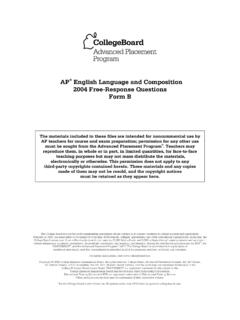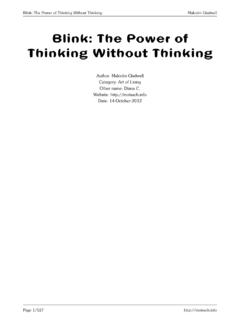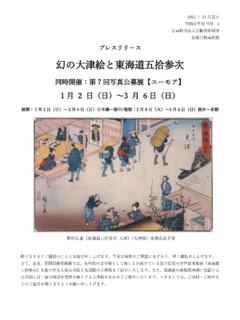Transcription of How To Use The Slide Rule - International Slide Rule Museum
1 A Seminar OnHow To Use The Slide RuleWritten by Mike Konshak, curator of the International Slide Rule Museum ( )with acknowledgments to Derek Ross and the Oughtred Society ( ) members "Dad says that anyone who can't use a Slide rule is a cultural illiterate and should not be allowed to vote. Mine is a beauty - a K&E 20-inch Log-log Duplex Decitrig" Have Space Suit - Will Travel, 1958. by Robert A. Heinlein (1907-1988) Apollo 11 - NASA's Lunar Lander space vehicle, with the crew Neil Armstrong, Buzz Aldrin and Michael Collins carried Slide rules, for the first time in history, into space and onto the moon, July, 1969. The Slide rule of choice was the aluminum pocket Pickett 600-T Dual base Log Log. We went to the moon with Slide rules, retiree Norman Chaffee, who worked on the spacecraft propulsion system, I didn t even have my first full-function calculator until 1972.
2 " Note: When you watch the movie Apollo 13 look for the engineers using Slide rulesThe HP-35 Slide Rule Calculator was first introduced in the mid-1970's,and sold for $295*.This calculator started the demise of the Slide rule industry. *$3000 in today's moneyPrior to 1980, Webster's Dictionary defined the word COMPUTER as a PERSONwho computes, typically with a Slide History of the Slide Rule1614 - Invention of logarithms by John Napier, Baron of Merchiston, - Developments of logarithms 'to base 10' by Henry Briggs, Professor of Mathematics, Oxford - Interpretation of logarithmic scale form by Edmund Gunter, Professor of Astronomy, - Invention of the Slide rule by the Reverend William Oughtred, - Development of the moving Slide /fixed stock principle by Seth Partridge, Surveyor/Mathematician, - Development of the Slide rule cursor by John Robertson of the Royal - Invention of the log log scale principle by Roget of - Am d e Mannheim, France, produced the modern arrangement of - Dennert & Pape, Germany.
3 Introduce white celluloid as a material for inscription of - William Cox of the United States patented the duplex Slide - Engine divided scales on celluloid increases precision of Slide - The final Slide rule made by K&E donated to the Smithsonian Institute, Washington, DC, , Slide rules can be found on eBay, antique stores and estate auctions. Lost inventories of brand new Slide rules turn up every OughtredJohn NapierAm d e MannheimTable of Contents (TOC) A Brief History the Slide Rule The Parts of a Slide Rule Reading the Scales Multiplication Simple Multiplication (uses C and D scales) 'Wrap-Around' Multiplication (uses C and D scales) Folded-Scale Multiplication (uses C, D, CF and DF scales) Multiplication by (uses D and DF scales) Division Simple Division (uses C and D scales) Reciprocal (uses C and CI scales) Trigonometry Sin(x) for angles between and 90 (uses S and C scales) Cos(x) for angles between and 90 (uses S and C scales) Tan(x) for angles between between and 45 (uses T and C scales) Tan(x) for angles between between 45 and 84 (uses backward T and CI scale) Tan(x)
4 For angles between between 45 and 84 (uses forward T and C scale) Sin(x) and tan(x) for angles between and (using the ST and C scales) Sin(x) and tan(x) for other small angles (using C and D scales) Squares and Square Roots Square (uses C and B scales) Square Root (uses C and B scales) Cubes and Cube Roots Cube (uses D and K scales) Cube Root (uses D and K scales) Log-Log Scales Raising a Number to Powers of 10 (N>1) Raising a Number to Powers of 10 (N<1) Raising a Number to Powers of -10 (N>1) or 1/X10 Finding the 10th Root (N>1> Finding the 10th Root (N<1) Arbitrary Powers (Staying on Same LL Scale) Arbitrary Powers (Switching LL Scales) Log-Log Approximations Slide Rule Loaner Program Additional Training Resources Parts of a Slide RuleThe scales on a Slide rule are logarithmic, in that the spacing between divisions (the lines on the scale) become closer together as the value increases.)
5 This is why the Slide rule is able to do multiplication and division rather than addition and subtraction. Compare the two sets of offset scales below in Figure B. In both cases the left index X:1 or C:1 is placed over the first whole number, either Y:2 or D:2. On a linear scale the value of any number on the X scale as read on Y is increased by 1. On a logarithmic scale, the value on any number on the C scale as read on the D scale becomes a multiple of the number under the index. William Oughtred discovered the above characteristic in 1630, when he placed two logarithmic scales that were invented by his contemporary, Edmund Gunter, alongside each other. Thus the Slide rule was the ScalesReading the Scales, Cont' this point it is best to just describe how to read the scales. On almost all Slide rules, the black scales (A, B, C, D, K, etc.)
6 Increase from left to right. The red scales, or inverse scales (CI, DI), increase from right to left. The pocket sized Pickett 600-ES will be used in most illustrations. The full sized Pickett N3-T for others. By the way, the Pickett 600-T (white) was taken by the Apollo 11 NASA astronauts to for 'folded', 'trig' or Log' scales, each scale begins with 1. C and D scales are single logarithmic (1-10) scales. The A and B scales are double logarithmic (1-10-100) having two cycles of 1-10, the K scale being triple logarithmic (1-10-100-1000) having three cycles of 1-10. The Primary divisions are whole numbers. The secondary divisions divide the Primary by 10, the Tertiary divisions divide the secondary by 5. Of course as you get to the end of each scale the divisions get so close together that the tertiary divisions disappear.
7 The scales on each side of a Slide rule are aligned so that calculations can be carried from one side to the the Scales, Cont' the left end of the scales, where the divisions are further apart, it is easy to judge the next decimal place value between in 1/10th increments (.1, .2, .3 etc) but on the other end, a hairline falling between two divisions might only be estimated as close as a half (.5). Its important to become familiar with not only the physical divisions as marked on the scales, but in becoming able to approximate values when the hairline falls in the spacing between divisions. Positions of the Slide and cursor shown in the examples will mention the label of the scale and the value on the scale, such as scale C at will be referenced as Approximating ValuesScientific Notation and Significant DigitsThe maximum resolution of a Slide rule is only 2-4 digits depending on which end of the scale is being read.
8 Additionally, The Slide rule does not tell you where the decimal point is located in the answer. To do a calculation with a Slide rule you reduce all numbers to scientific notation with 2-4 digits then use the Slide rule to perform the basic operations. In a separate calculation you find the order of magnitude by combining the powers of 10. It is up to the operator to determine if the result makes sense or not..Suppose you were given that the earth's diameter at the equator is 7, miles and you are asked to find the circumference using C= DThe value for , for example is but for Slide rule calculations we round that to or We would round D= to x 1000 or x 103 Scientific Notation and Significant Digits, cont'dNow its a simple task of using the Slide rule to multiply x x 1000 The final result on the Slide rule would have read , but we can easily mentally calculate that 3 x 8 = 24, so what you are seeing should be We then add the 3 decimal places (the zero's in 1000) to shift the decimal point to 24,900 talking with someone you might further round off your answer to say that the earth's circumference at the equator is about 25,000 miles, and for all practical purposes you'd be correct.
9 Your calculator gave you an answer of 24, , but you'd be a real boor if you rattled off that number to your friends. The difference between 24,900, 25,000 or 24, is less than a one-half of one percent, so the error is very small. Remember we made it to the moon and engineered every structure you see before 1970 using Slide rule curse and blessing of modern calculators is that this type of thinking is no longer necessary or encouraged by educators. Students just hit buttons and copy down what is on the display. Of course the fact that most of the digits in the display of a calculator is useless noise does not bother most students. Modern students are not challenged to judge whether or not the calculator's result is in the right range, and errors can be propagated1. Simple Multiplication (uses C and D scales)Example: calculate Slide the leftmost Index '1' on C over on the D scale.
10 Move the cursor to on the C scale. The cursor is on the D scale just a bit over or This is the 'Wrap-Around' Multiplication (uses C and D scales)Example 2a: calculate Move the left Index on C to on the D scale. Try to move the cursor to on the C scale. The cursor is blocked by the brace (also called strap or bridge). The target is off the D scale. The right Index must now be used. Example 2b: calculate Move the right Index on C (C:1) to over on the D scale ( ) Slide the cursor to on the C scale ( ) On the D scale, you'll see that the hairline is between divisions. Estimate the answer to Do a rough approximation by rounding to 2 and to 5. We mentally calculate 2 5 = 10, so we adjust the decimal place to get or 3. Folded-Scale Multiplication (uses C, D, CF and DF scales) Example 3: calculate Slide the leftmost Index, '1', on C over the on the D scale ( ).







